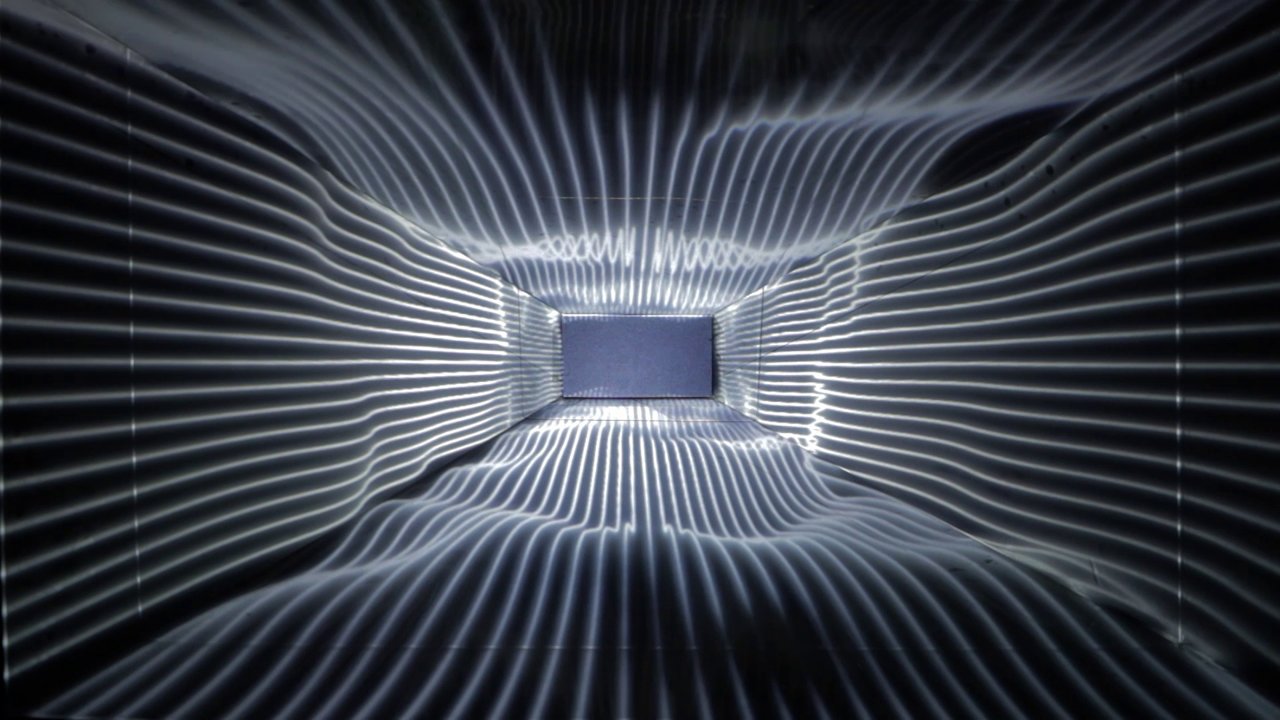

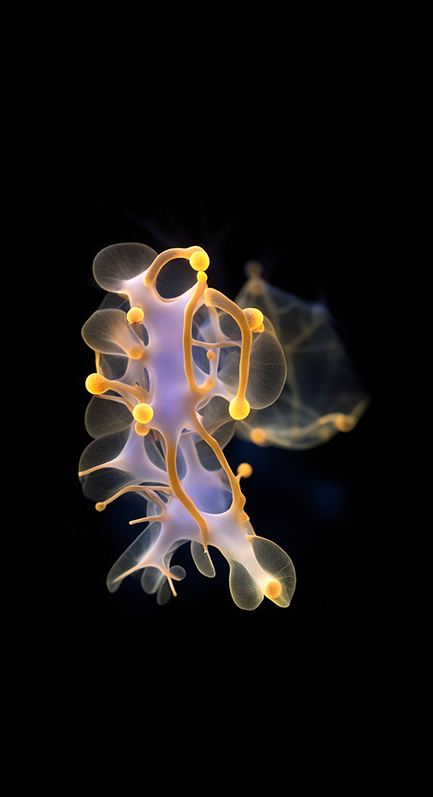
Memo Akten and Katie Peyton Hofstadter
Embodied Simulation
‘Embodied Simulation’ is a multiscreen video and sound installation that aims to provoke and nurture strong connections to the global ecosystems of which we are a part. The work combines artificial intelligence with dance and research from neuroscience to create an immersive, embodied experience, extending the viewer’s bodily perception beyond the skin, and into the environment.
The cognitive phenomenon of embodied simulation (an evolved and refined version of ‘mirror neurons’ theory) refers to the way we feel and embody the movement of others, as if they are happening in our own bodies. The brain of an observer unconsciously mirrors the movements of others, all the way through to the planning and simulating execution of the movements in their own body. This can even be seen in situations such as embodying and ‘feeling’ the movement of fabric blowing in the wind. As Vittorio Gallese writes, “By means of a shared neural state realized in two different bodies that nevertheless obey to the same functional rules, the ‘objectual other’ becomes ‘another self’.”

Clara Daguin
Oracle Collection
The performance centered around ORACLE, a digital palm reading given by model and iconic muse Axelle Doué. The surrounding luminous dresses embodying the four elements— air, earth, water, and fire—come alive during the reading, with mirrors reflecting them into infinity. The pieces are crafted from diverse materials, both natural and synthetic. Well beyond typical textiles, Clara Daguin implements optical fibers, pleating, embroidered circuits, addressable LEDs, sculpted resin, home-grown alum stone crystals, Swarovski Elements, silk organza, microcontrollers and radio frequency modules.

Olafur Eliasson
DET LYTTENDE SPEJL
Visitors to DNV-Gødstrup, a new hospital near Herning, Denmark, are greeted at the main entrance by an airy, round pavilion. Two curved pipes, crossing one another perpendicularly, hold a large disc aloft at a slight angle. The reflective underside of the disc mirrors the semicircular pipes, creating the illusion of two complete circles passing through the ceiling and rising into an imaginary space above. As visitors enter the pavilion, they can gaze up at their own reflections in the mirror and see themselves incorporated, upside down, into the artwork, embraced within the globe drawn by the pipes. The tilt of the ceiling allows the reflections to be seen from the outside. As the viewer moves towards and around the pavilion, the rings appear to shift in shape, changing from ellipses to circles and back again.

bohyun yoon
БОХЬЮН ЮН
윤보현
To Reverse Yourself
My work poses the question: how does reality becomes exquisitely animated by certain social control systems such as politics, mass media, technology, science, and etc. It is my artistic goal to reveal how human beings are fragile and delicate in these social environments. By living in Korea, Japan and the U.S, I have first-hand experience in diverse social systems and have come to view my life experiences as raw material for my research. With my research in mind, my art utilizes the body as the tool for an intensive investigation of the public and private; examining the relationship between how people understand their body and how this understanding represents themselves in the greater context.
Currently, I am curious about human perception developing parallel with the ever-evolving progression of technological world. Thus, I question technology’s relationship to reality and illusion; asking what is reality? My work takes advantage of illusion to explore and answer this question, and often my artistic materials consist of the body and mirrors. I use mirrors for integrating reality and illusion.

Playmodes Studio
“Espills” is a solid light dynamic sculpture. Built using laser beams, laser scanners and robotic mirrors, it is inspired by crystalline formations. A set of geometric figures that float in the air and which suggest, in an abstract way, the transmutation of matter from chaos to order. Dust becoming crystal, being eroded and becoming sand again.

Daniel Rozin
Darwinian Rotating Lines Mirror
Questo è il terzo pezzo della serie di Darwinian Software Mirrors. In queste opere la “pressione evolutiva” programmata spinge le opere d’arte ad assomigliare all’immagine speculare dello spettatore. Coinvolgendo lo spettatore con una risposta interattiva, ogni opera varia le proprietà formali di linea, luminosità e tempo, poiché le immagini basate sullo schermo sono costruite in modo improvvisato.

Oli Sorenson
Video Pistoletto
FILE-FESTIVAL
The latest of Oli Sorenson’s remix series is directly inspired by Michelangelo Pistoletto’s (1933) celebrated shattering of large mirrors.

Kenny Wong
Squint
file festival
I was inspired by how the sunlight bounces around in our artificial forest.
“Squint” is a kinetic light installation consisting of 49 mirrors that reflect lights in a bright space. The mirrors track and reflect lights on audiences’ face with composed patterns of movements. It extends the generated perception by focusing on how lights pass across our visual senses physically, and combines with our perception of images through flickering. “Squint”, which extracts various daily experiences to an abstraction brings the audience to expand their interpretation of lights and perceived imagination into a non-linear experience.
“Squint” simulates light source and intentionally shines lights on audience’s faces. Bright light is projected in the gallery, a clean bright space.
Everyday people are dynamically moving around in the city. Sunlight reflects and flickers even when it is indirect and hidden behind the artifacts. While we are traveling, we are experiencing motion. We are also experiencing the shift of light intensity, visual patterns and textures. The varieties of light forms inspire the artist to explore the potential of light textures, select and sort out the combined complexity in urban space. The artist turns them into a minimal form of light experience, while maximizing its diversity of perception.
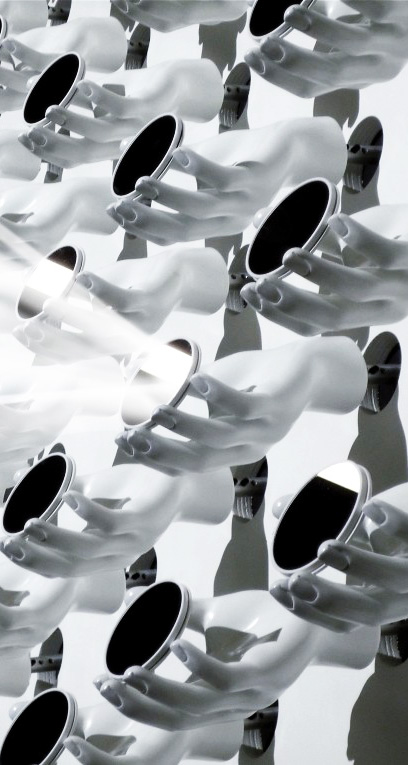
ART+COM
IN MEMORIAM
Joachim Sauter
1959-2021
R.I.P
ART+COM Studios
MOBILITY
THE INSTALLATION SPANS A CORRIDOR OF 7-METRES WIDTH. ON THE LEFT WALL ONE HUNDRED PROSTHETIC HANDS ARRANGED IN A MATRIX REVOLVE AROUND THEIR OWN VERTICAL AXIS, THE MOVEMENTS BEING CONTROLLED BY MOTORS. THE MIRRORS THEY HOLD REFLECT THE BEAM OF A STRONG LIGHT ACROSS THE SPACE AND ONTO THE OPPOSITE WALL. WHAT INITIALLY SEEMS LIKE AN ASYNCHRONOUS, CHAOTIC PATTERN OF MOVEMENT SOON REVEALS ITSELF AS A COMPLEX, COMPUTATIONAL
.
流动性
该安装跨越了7米宽的走廊。在左墙上,排列成矩阵的一百个假肢手绕其自身的垂直轴旋转,其运动由电动机控制。他们持有的镜子将强光光束反射穿过整个空间并射向对面的墙壁。最初看起来像是一个异步的,混乱的运动模式,很快就显示出一种复杂的计算编排:首先,一百个光点围绕一个中心点移动,类似于行星的天体动力学或昆虫群的飞行模式。并创造出三维空间的印象。然后突然之间,这种有机振动会聚成一个表示运动和动作的汉字。

Tigre Lab
Mixed Mirrors
Mixed Mirrors es una instalación para crear un lugar para reunirse y pasar un buen rato con un grupo de personas que funcionan como un todo para crear una identidad. Especialmente en estos años, la mayoría de nuestras interacciones son puramente digitales y frías en la distancia. Por eso, queríamos crear un espacio que, explotando estos mismos recursos digitales, quiera crear una conexión más física y real. Un foco, una chimenea, un faro que ilumina y atrae a personas que no se conocen que pueden interactuar reflejando sus rostros en un espejo que fusionará todos los rostros en uno.

Bohyun Yoon
Mirror Armor
Being entrapped in narcissism is like a “self-jail”. Placing the mirror armor fixtures over my nude body causes the viewer to see the pixelated and fragmented image of myself. Usually covering, hiding, pretending to be a version of myself on the outside, therefore, “good looking” seems more of decoration or in itself a type of armor suitable for public viewing. Will these mirrors of self reflection cause me to wonder who I am on a deeper level? To discover who I truly am, what I am afraid of, why I waste my life without discovering my inner self. I constantly struggle with how I can break this boundary because I want to wake from this oblivion.

clement valla
Valla claimed to have collected a series of 60 “surrealistic” images, or that, at least, give that impression, during a long period “playing” in Google Earth.“The images are a kind of mirrors for a fun house.They are strange illusions and reflections of the real ”Despite the strong distortions, which easily resemble a surrealist painting, the images of the work do not have any manipulation of tools like Photoshop, for example.”The images are screenshots of Earth with basic color adjustments”, “This is a construction of 3D maps on two-dimensional bases, creating these fabulous and unintended distortions”.

Ryoichi Kurokawa
s.asmbli[wall]
Get immersed by 360° projections on a gigantic cube at OCT Loft Creative Festival and surround yourself with the power of nature. Thanks to a well-chosen combination of front and rear projection screens, you can enjoy the immersive fabric projections from every possible angle. To enhance the immersive 360-feel, several mirrors were placed around the eye-catching sculpture, reflecting the high-quality video mapping beautifully.
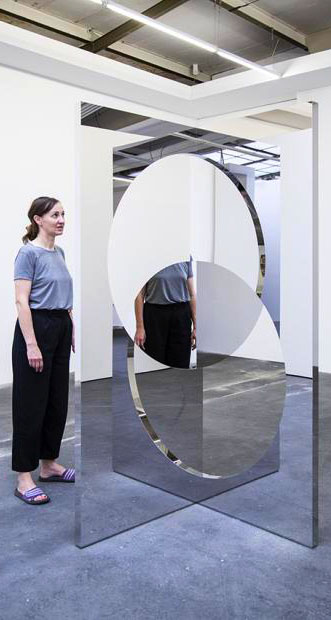
Jeppe Hein
Geometric mirrors
Geometric Mirrors is a series of mirror angles, each comprised of two mirror surfaces intersecting at a 90° angle. While a perpendicular viewpoint simply reflects the viewer and the opposite space, an interesting visual phenomenon occurs when the viewer faces the corner angle directly. The right angle causes a duplicate reflection, as both mirrors reflect not only the space but also each other. Their widths become extended into the adjoining side, thus appearing to the viewer as a mirrored cross rather than a mirrored angle.

Kimchi and Chips
Difference and Repetition
The title references Deleuze’s thesis ‘Difference and Repetition’ – his attempt to understand reality without referring to identities. The artists aim to ‘unidentify’ the audience – to criticize the bubbles of reality which technology has helped us to build around ourselves. By allowing ourselves to remove our identity occasionally, we can better understand the thoughts of those we disagree with and therefore better work together to build a combined reality. Difference (in both senses) is generated by the motion control system which continuously changes the pose of the mirrors relative to the viewer. This movement disrupts space itself, creating a transformation similar to that of a Lorentz transformation when one travels close to the speed of light. This causes space itself to compress, twist and break, giving the viewer a tool for observing the non-absolute nature of time.
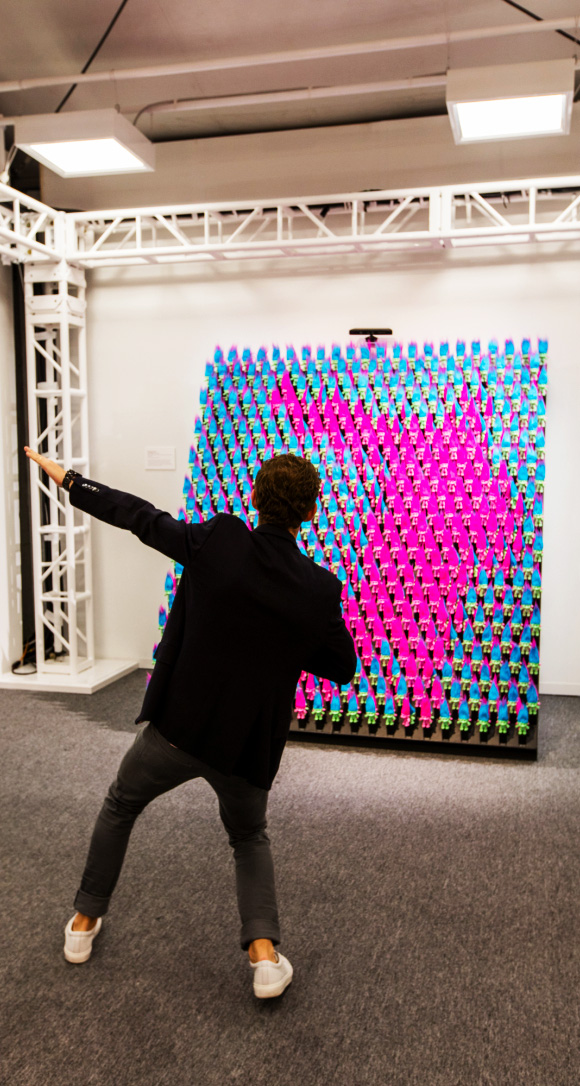
Daniel Rozin
Troll Mirror
The mechanical mirrors are made of various materials but share the same behavior and interaction; any person standing in front of one of these pieces is instantly reflected on its surface. The mechanical mirrors all have video cameras, motors and computers on board and produce a soothing sound as the viewer interacts with them. Troll Mirror was commisioned by Traget and is made of pairs of pink and blue troll dolls. Every troll doll pair can rotate so that the pink or blue troll face the front. The result is a colorfull reflection of the viewer’s outline and playfull colorfull transitions

Kohei Nawa
Throne
This work attempts to express that premonition as an immense “floating vacant throne”. If instances of power and authority have ruled since ancient times, and the pyramids provide one example—we must ask what the future will hold. Created with reference to the forms of festival floats and portable shrines that appear in the rituals and festivities of the East, the sculpture fuses today’s 3D modeling techniques with gold leaf applications that date back to ancient Egypt. In the frontal center is an empty room, space enough for a 2 to 3-year-old child to sit, suggesting that the new intelligence is still in a young state. Shining, spherical mirrors placed at the center in front and back. Made of platinum foil, they represent “the eyes overlooking the world”, where the frontal one faces the future and the back reflects into the past.

Lucid Creates
Futures
Futures uses the optical illusions created by light, sound and mirrors to transport audiences to a place where good things have happened and the future we want exists now. Futures is an immersive space in which audiences experience illusions that can reveal everything from how they process space and time to their perception of consciousness. It is a modular light installation that takes a number of forms. It is shown here as a walkway of mirrors and lights, tunnelling inwards towards a vanishing point.

SARAH OPPENHEIMER
사라 오펜하이머
D-33
NYC-based artist Sarah Oppenheimer‘s work blurs the line between sculpture and architecture. Her amazing installations usually involve moving walls, slanting floors, and creating apertures—sometimes symmetric, sometimes asymmetric, and often with mirrors—that would mesmerize (and confuse) the most resistant of gallery/museum guests.
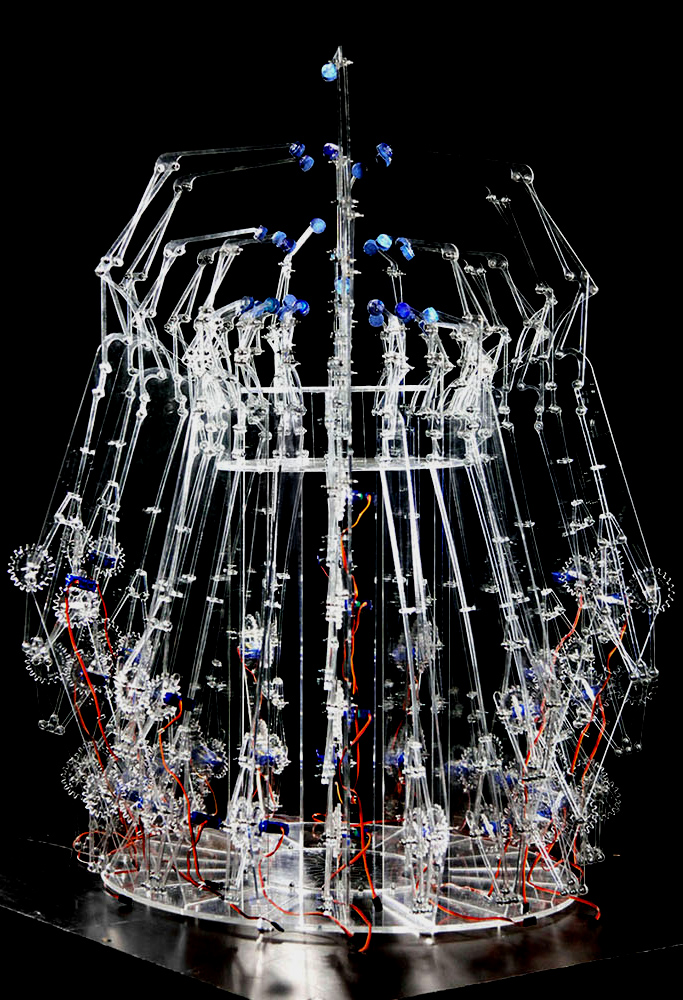
jeanine jannetje
reawaken
Reawaken is a kinetic sculpture with 55 robotic arms, powered by 55 servo motors. The lowering of the arms causes an abstract print on paper. Technology mirrors humanity, and vice versa. In addition to creating beauty, technology is there to meet our needs. We, and our needs, have evolved to a point where we are so integrated that we consume technology on autopilot. We live in a time of mass production in which our daily devices increasingly mimick each other. A smartphone is a small tablet, a tablet a small computer and a computer a small television. The question of what this does with our imagination, together with the increasingly invisible technological progress such as algorithms and artificial intelligence, have been my starting point for Reawaken.

Michiko Tsuda
YOU WOULD COME BACK THERE TO SEE ME AGAIN THE FOLLOWING DAY
This installation utilizes mirrors and video cameras combined with various types of frame, a motif often discussed in the context of the history of painting and film. The title is a typical English sentence in free indirect speech (by what is normally a third-person subject). With the object of “there” and “following day” varying with the context, this title reflects the experience of viewers, whose relationship to their image and to the space raises questions about the meaning of “here” and “now.”

Kimchi and chips
Halo
99 robotic mirrors continuously move throughout the day to follow the sun like sunflowers. These mirrors, arrayed across two 5 meter tall towers and one 15 meter long track, each emit a beam of sunlight into a cloud of water mist. The beams are computationally aligned so that together they draw a bright circle in the air. Dependent entirely on the presence of the sun for its completion, the work explores the possibilities and limitations of technology to capture what is out of reach, to harness nature and bring the sun down to earth. Collaborating with the natural fluctuations in the climate, Halo appears only for moments when the wind, sun, water, and technology coincide, creating a form which exists between the material and immaterial.

christopher bauder
skalar
SKALAR is a large-scale art installation that explores the complex impact of light and sound on human perception. Light artist Christopher Bauder and musician Kangding Ray give an audio-visual narration of radiant light vector drawings and multi-dimensional sound inside the pitch-dark industrial space of Kraftwerk Berlin. By combining a vast array of kinetic mirrors, perfectly synchronized moving lights and a sophisticated multi-channel sound system, SKALAR reflects on the fundamental nature and essence of basic human emotions.

Random International
Fragments
Almost two hundred identical, small mirrors are arranged in a grid to form a flat, homogenous surface. Hung against the wall, the mirrors are closely spaced and apparently static; but they possess the ability to move in harmony with one another. Approaching the artwork, the individual mirrors turn together to face the onlooker, following as he or she moves. The plane of the surface distorts into varying, three-dimensional forms — perhaps a wave, or a curve, or a circle. The reflection becomes fragmented and the apparently inanimate object becomes akin to something organic and alive

olafur eliasson
Seeing spheres
Each of olafur eliasson’s seeing spheres supports a flat, circular mirrored face, framed by a ring of LED lights, which is oriented inward to reflect the mirrored faces of the surrounding spheres. Together they produce a surprising environment of multilayered, reflected spaces in which the same people and settings appear again and again, visible from various unexpected angles. Tunnel-like sets of nested reflections open up in the mirrors, repeating countless times and disappearing into the distance.
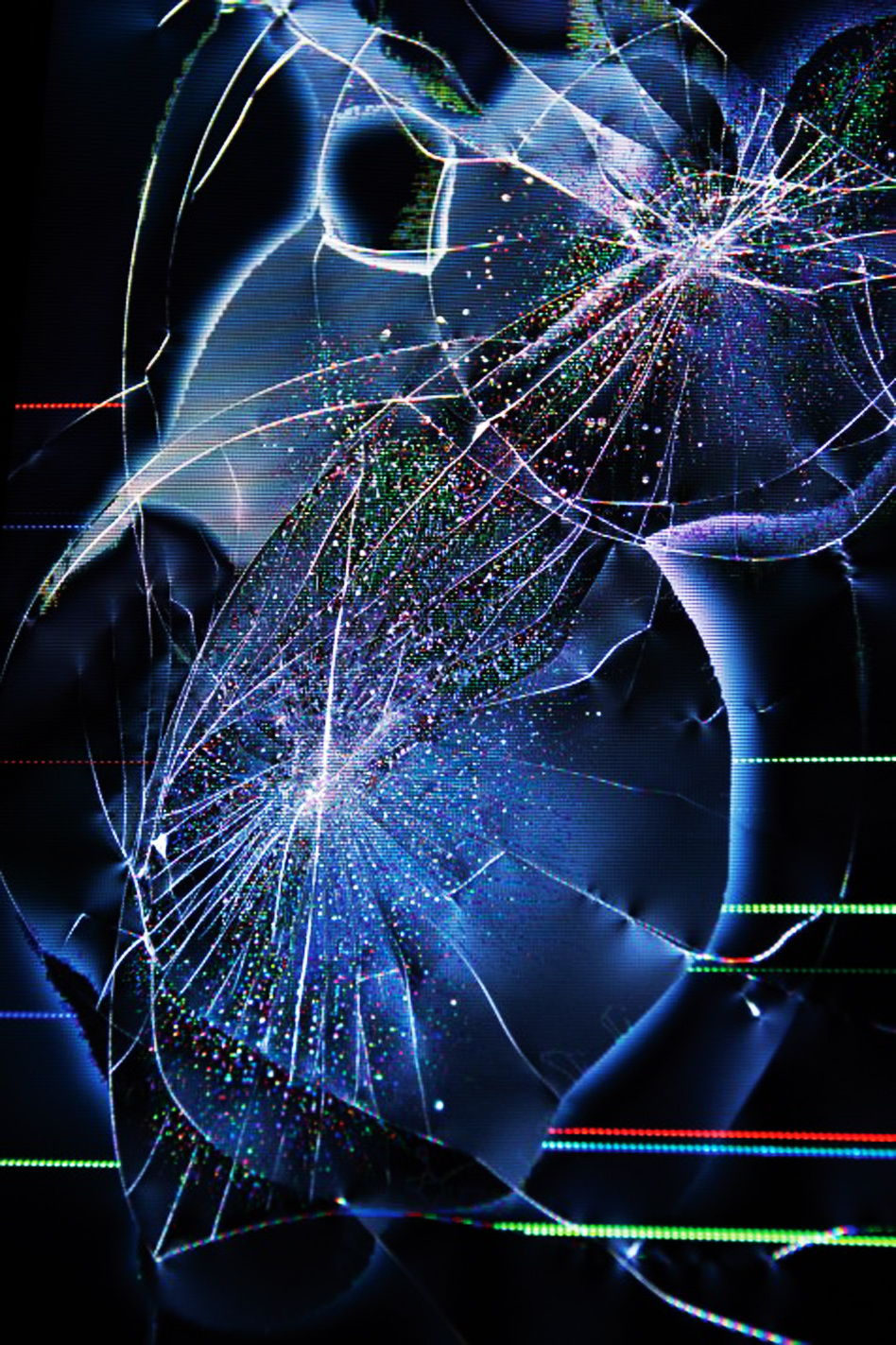
Oli Sorenson
LA SOCIETE DE LA PLACE DES SPECTACLES
FILE SAO PAULO 2015
Inspired from the live works of Italian artist Michelangelo Pistoletto (1933-) of meticulously ransacking large mirrors, Sorenson revisited the classical traditions of vanitas under the materiality of video, and generate his creative process from the destruction of consumer components.
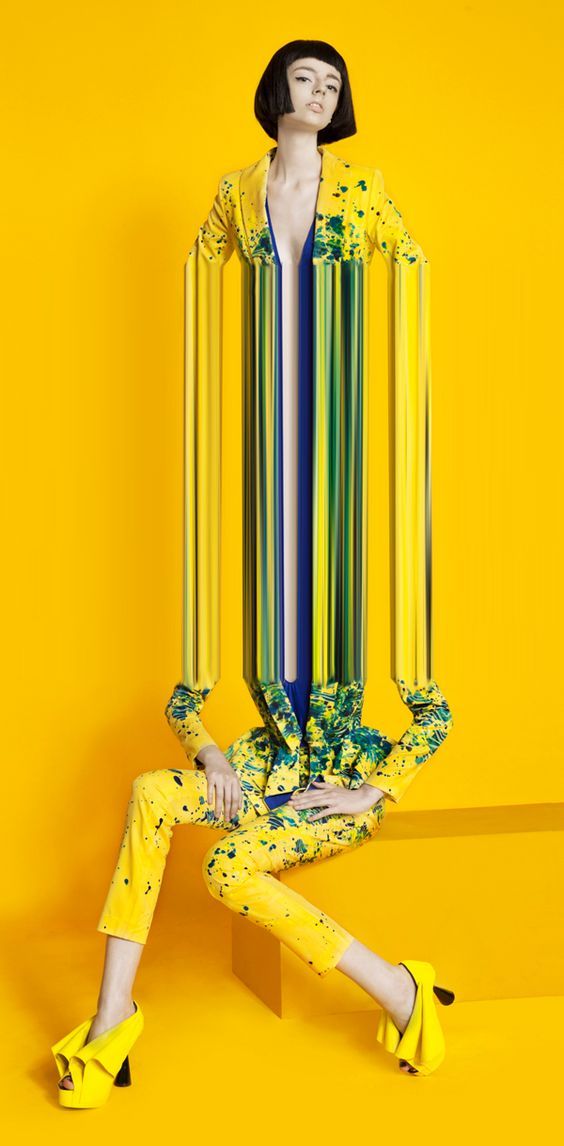
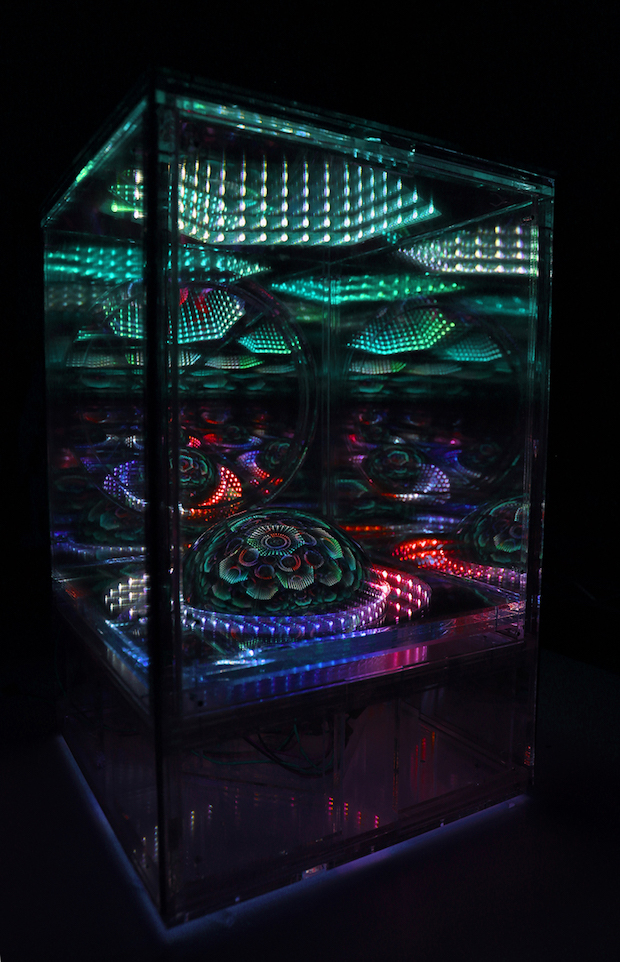
gabriel pulecio
Saturn Submerged
Saturn Submerged is part of an ongoing series of infinite boxes that creates an expanded infinite space within itself. The sculpture is composed of multiple mirrored surfaces and LEDs, which are fused to create the illusion of infinite depth and imagery. Mirrors include convex domes and walls; LEDs are programmed to continuously change in randomized combinations of almost infinite colors and sequences based on several variables.

LEYLA CARDENAS
Periplo (detail)
Based in Bogotá and represented there by Casas Riegner, Leyla Cardenas engages with the remnants and artifacts of destruction, the seen and unseen, the visible and invisible. Working with found object and images from archives, often her process mirrors that of an archeologist since she procures fragments such as walls, ceilings and floors to produce her work.

joan jonas
Джоан Джонас
جوان جوناس
조안 조나스
ジョーン・ジョナス
Joan Jonas, believing that sculpture and painting were exhausted mediums, became known for her pioneering work in performance and video art. Jonas, who studied sculpture and art history, was deeply influenced by the work of Trisha Brown, with whom she studied dance, as well as John Cage and Claes Oldenburg, particular in their exploration of non-linear narrative structure and form. Jonas’s own work has frequently engaged and questioned portrayals of female identity in theatric and self-reflexive ways, using ritual-like gestures, masks, mirrors, and costumes.

BROOKHART JONQUIL
Brookhart Jonquil’s abstract sculptures expand on the discourse of postminimalist art. Using unusual and highly aestheticized construction materials and consumer goods—such as two-by-fours, mirrors, neon lights, and magicians’ flash paper—Jonquil mines the histories of postwar abstract sculpture and scientific imagery.

Mattia Paco Rizzi + Jessica Bergstein-Collay
Taumascopio
‘Taumascopio’ is an art installation designed and realized by parisian architect-artist mattia paco rizzi for the 2014 kanal playground festival in brussels, belgium. the structure is completely covered with mirrors and as a result, offers a complete visual camouflage along the molenbeek’s canal. as its exterior panels fold, the overall massing creates a kaleidoscopic effect that reacts to heat. during the temperature’s evolution throughout the day, the surfaces present an ever-changing reflective effect. ‘the ‘taumascopio’ invites us to reflect in poetic vein on public space, like a box of delights that gives us multiple visions and allows us to see the city differently,’ says rizzi. ‘the mosaic of reflections sends our thoughts in new directions and invite us to create new ideas.’

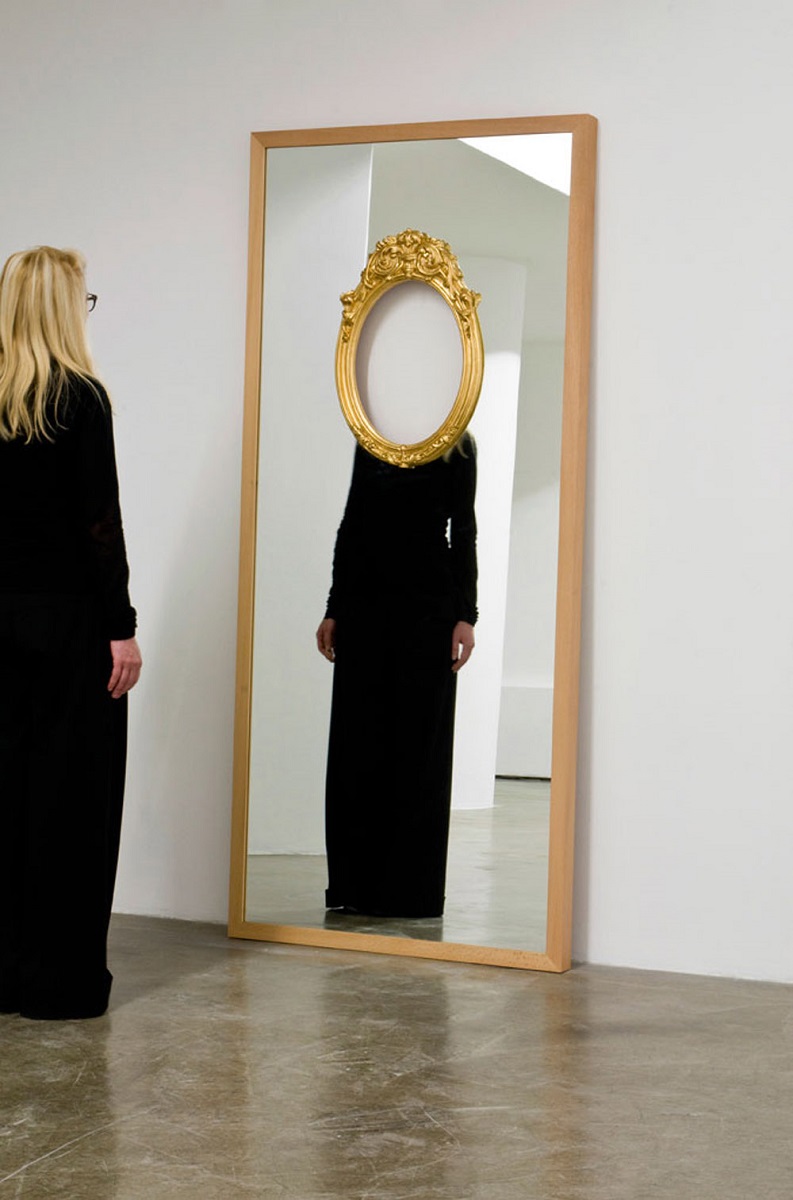
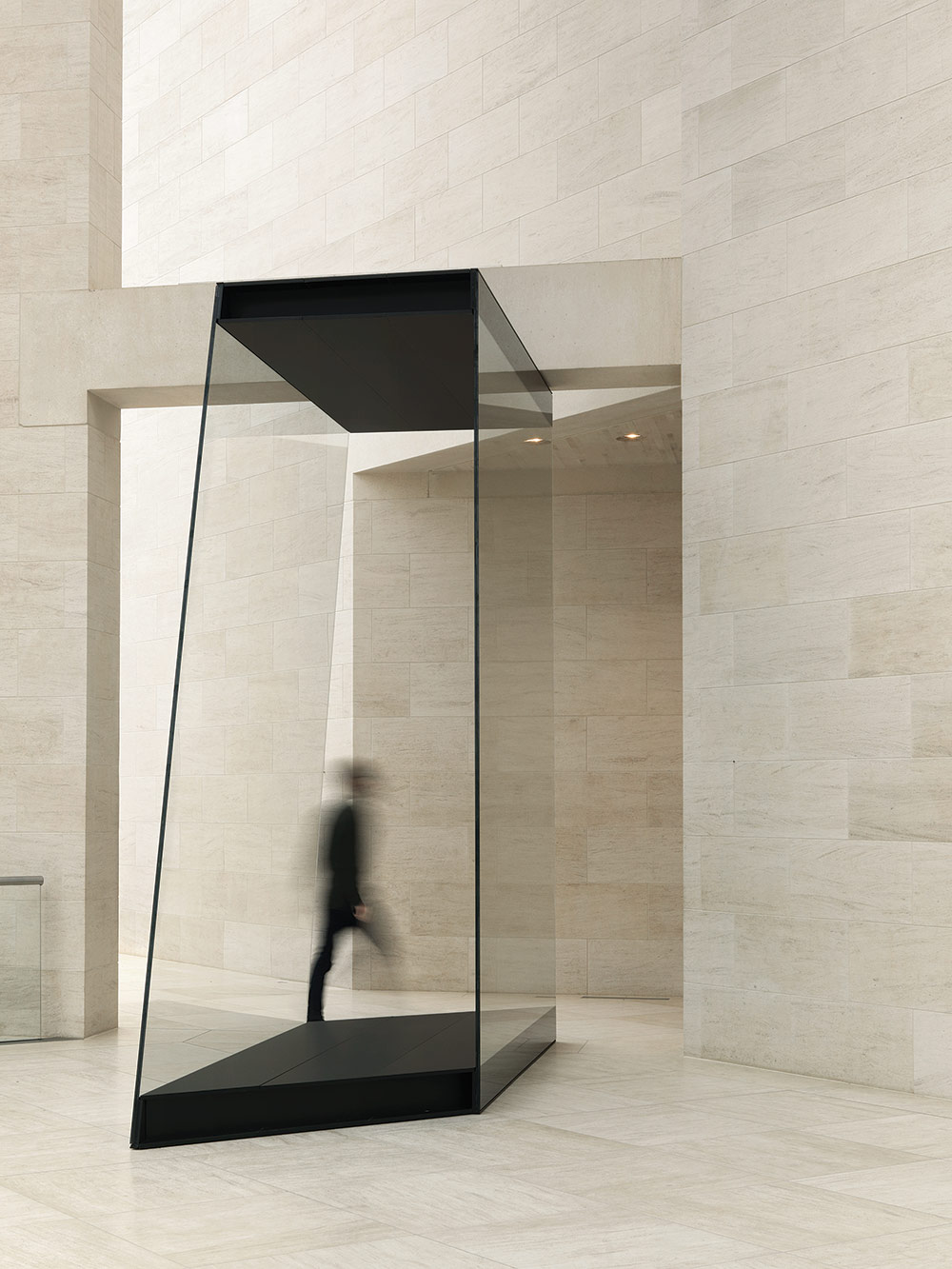
SARAH OPPENHEIMER
사라 오펜하이머
NYC-based artist Sarah Oppenheimer‘s work blurs the line between sculpture and architecture. Her amazing installations usually involve moving walls, slanting floors, and creating apertures—sometimes symmetric, sometimes asymmetric, and often with mirrors—that would mesmerize (and confuse) the most resistant of gallery/museum guests.

OLI SORENSON
video pistoletto
FILE SAO PAULO 2015
Inspired from the live works of Italian artist Michelangelo Pistoletto (1933-) of meticulously ransacking large mirrors, Sorenson revisited the classical traditions of vanitas under new materials together with one of the more celebrated exploits of Arte Povera.

OLAFUR ELIASSON
オラファー·エリアソン
اولافور الياسون
奥拉维尔·埃利亚松
אולאפור אליאסון
ОЛАФУР ЭЛИАССОН
Visual mediation
Eliasson constructions, at once eccentric and highly geometric, use multicolored washes, focused projections of light, mirrors, and elements such as water, stone, and moss to shift the viewer’s perception of place and self. By transforming the gallery into a hybrid space of nature and culture, Eliasson prompts an intensive engagement with the world and offers a fresh consideration of everyday life.

Doug Aitken
ダグエイケン
道格·艾特肯
Underwater Pavilions
At around 12 feet in diameter, each one is big enough to swim through, for divers and fish alike. Aitken sculpted the pavilions from mirrors and artificial rock, and collaborated with a range of specialists to submerge them in the local dive park and moor them to the ocean floor. But building and installing these structures wasn’t easy. Aitken wants his exhibit to raise awareness about the declining health of the oceans.

Blaise Cepis
Brooklyn-based photographer Blaise Cepis makes pictures that are all, in some way, “not-quite-right”. Sometimes this “offness” is overt – many of his images pair naked models with mirrors or printouts in a way that renders the scene abstract. And sometimes this offness is more subtle – Blaise is drawn to scenes that feel a lot like raw mistakes, the kind that yield sterility where there should be warmth, or sexlessness where you’d expect sex.

vincent leroy
文森特·勒罗伊
北极光环
stone age
Paris-based artist vincent leroy takes movement as the motivation for his work. he prefers this over form, material, or color. instead, he focuses on adding rhythm, pauses, and creating different patterns to set and differentiate every piece. ‘stone age’ is his latest sculpture and is made of fourteen triangular mirrors that move subtly, breaking its surroundings into thin reflections of space. these mirror images deconstruct the environment allowing for different visions of it.
This sculpture situates itself between poetry and technology, generating the opportunity to test visual and physical experiences that relate to space. ‘stone age’ looks like a heavy and rigid structure, but it will surprise the user when it twists and deforms with flexibility and fluidity, creating a delicate contrast. all the movement is created using very low technology.

ART+COM
Mobility
The installation spans a corridor of 7-metres width. On the left wall one hundred prosthetic hands arranged in a matrix revolve around their own vertical axis, the movements being controlled by motors. The mirrors they hold reflect the beam of a strong light across the space and onto the opposite wall. What initially seems like an asynchronous, chaotic pattern of movement soon reveals itself as a complex, computational choreography: at first the hundred light spots move around a central point, akin to the celestial dynamics of the planets or the flight pattern of a swarm of insects and creating the impression of a three-dimensional space. Then suddenly this organic oscillation converges to form a Chinese character denoting movement and action.

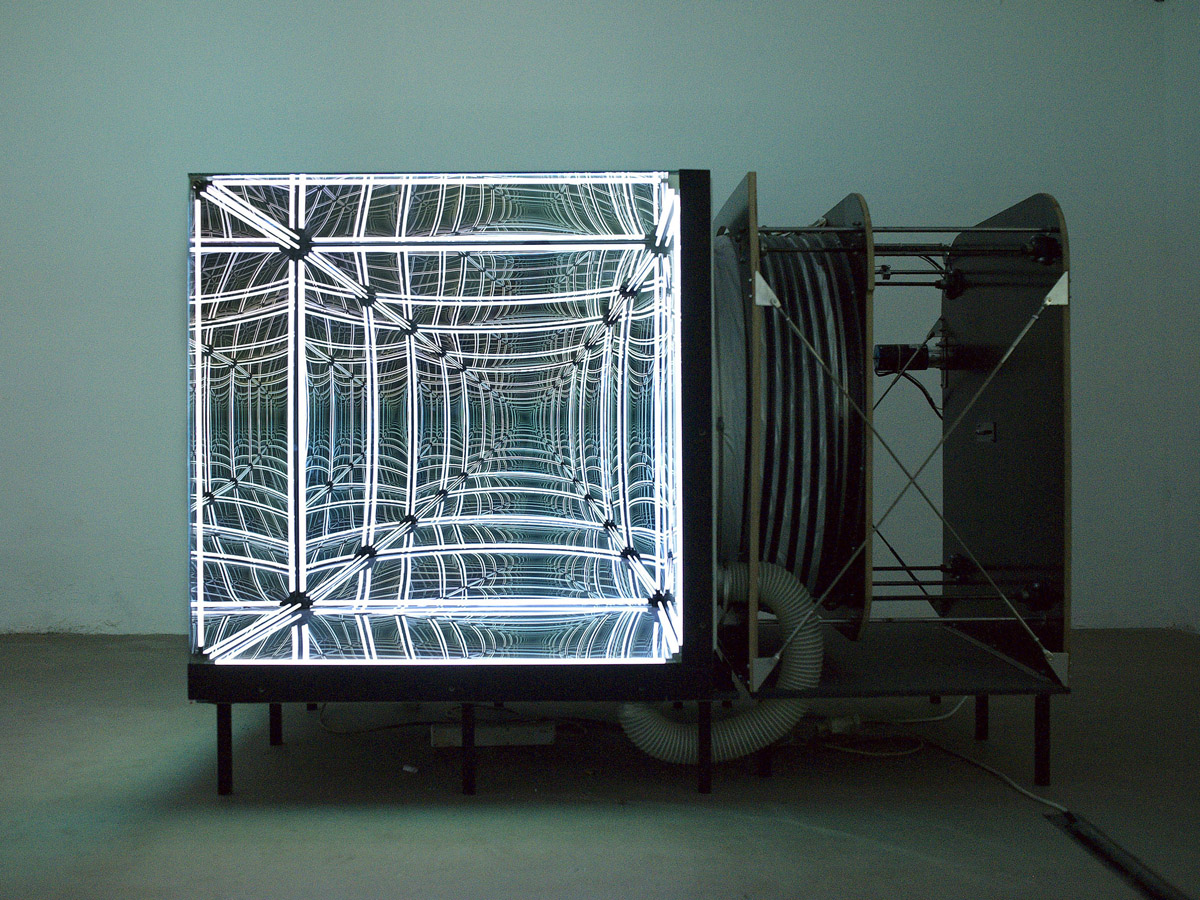
Numen/For Use
N-Light Membrane
Built and designed by Numen/For Use, N-Light Membrane is a giant cube with three out of the six surfaces made of flexible membrane (foil mirror) with an air tank and a compressor connected to it. The other three mirrors are semi transparent spy-glass. By inflating or deflating the air tank, the membrane turns convex or concave, deforming the reflections within.

Jean Cocteau
جان كوكتو
让·科克托
ז’אן קוקטו
ジャン·コクトー
장 콕토
ЖАН КОКТО
Orphée
“The three basic themes of Orphée are:1-The successive deaths through which a poet must pass before he becomes, in that admirable line from Mallarmé, tel qu’en lui-même enfin l’éternité le change—changed into himself at last by eternity.2-The theme of immortality: the person who represents Orphée’s Death sacrifices herself and abolishes herself to make the poet immortal.3-Mirrors: we watch ourselves grow old in mirrors. They bring us closer to death.
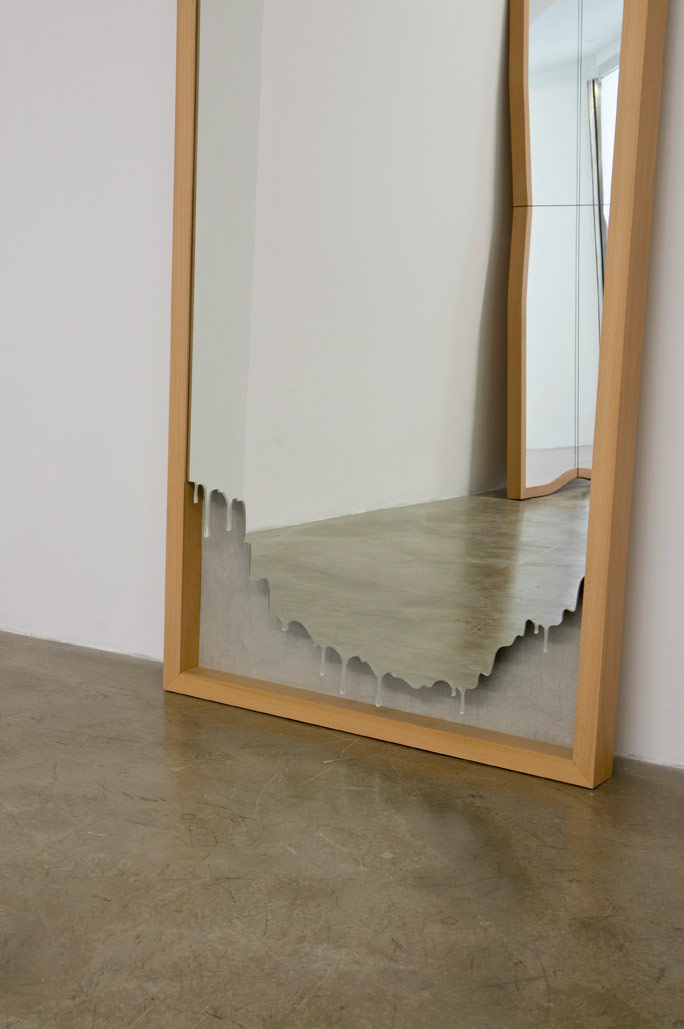
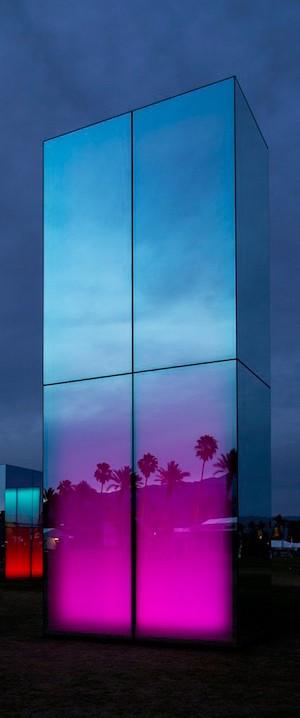
phillip k smith III
mirrors reflection field for coachella

Alicja Kwade
Die Gesamtheit aller Orte
“It’s easy to trace the curves in Kwade’s perfectly placed bent tubing and piping, but it takes a second to realize that even the installation’s larger, solid objects—a door, a window, mirrors, iron gates, sheets of metal, and even a bicycle—not only travel on her orbits’ paths, but have also been altered (in some cases just barely) to conform to them. The white door’s slight curvature is hardly noticeable until you’re at close range. The imposing rusty gates are generously rounded. There’s an almost imperceptible bend to a door with an oval mirror. A few copper pipes in the outermost rings disappear into the gallery wall; in the very center of the installation, a two-euro coin, propped up on its rim, and a sharply curved sheet of metal face each other, mysteriously.”Kimberly Bradley
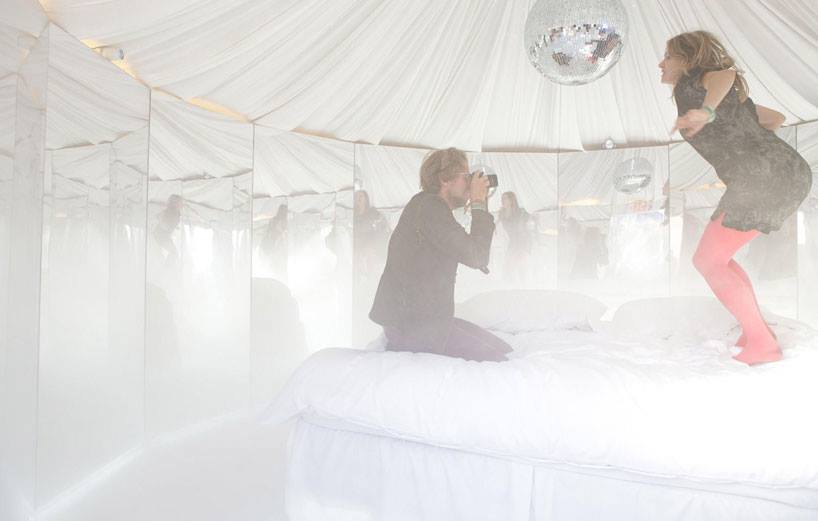
URS FISCHER
Урс Фишер
nomadic art tent
The nomadic sculpture that Urs Fischer created for Station to Station is something of a steamy interior dreamscape, a glittery, shimmering vision that hypnotizes with lights and textures that both welcome and disorient. In the center of the piece is a plush Hasten’s bed on which viewers lie surrounded on all sides by mirrors and cloud-like smoke. A disco ball rotates above. Is this a place for disco naps? Or is it a glamorous fantasy of decadence and visual riches? Spend some time, look at yourself in the many reflective surfaces, and feel the bedding against your skin and decide for yourself. Dreamy as it is, this space is grounded in the real world and governed by the laws of physics. This place seems like a fantasy, but it is entirely real. As one critic noted of an earlier Fischer work:In a world increasingly defined by virtual realities and digital imaging, is the creative mastery of hand manufacture merely a quaint artistic throwback — nostalgia for a lost cultural past? Is this sculpture a memorial? Given today’s ubiquitous special effects wizardry, shouldn’t art clasp technology to its bosom? There’s nothing virtual about the softness of the bed, nothing digital about the gleam of those lights or the mist surrounding you. Take off your shoes. Climb inside. This is real life.

SUZAN DRUMMEN
kaleidoscopic crystal floor
dutch artist suzan drummen’s large-scale floor installations are mesmerizing and complex circular patterns made out of mirrors and brightly colored glass. the fractal-like arrangements feature ornate and elaborate circles growing exponentially out of each other and vibrant rings of spiraling colors winding into the surface of the floor. they are composed of crystals, chromed metal, precious stones, mirrors and optical glass. a sensory experience, and visually stimulating, the glittering installations play with the architecture of the space — climbing up walls and sweeping across the surfaces — examining the idea of illusion and optical effects.

